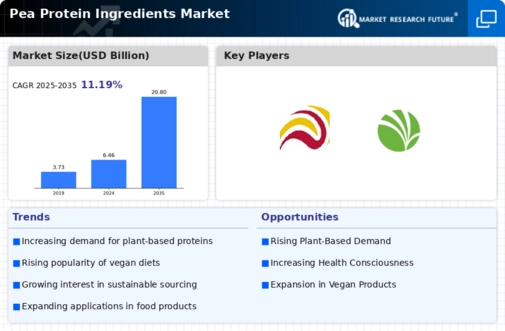Market Analysis
In-depth Analysis of Pea Protein Ingredient Market Industry Landscape
The pea protein ingredients market is experiencing dynamic changes driven by a combination of factors that influence its growth trajectory. A significant driver of this market is the growing consumer preference for plant-based protein sources. As more individuals embrace vegetarian and vegan lifestyles, pea protein has emerged as a popular choice due to its complete amino acid profile and allergen-friendly nature. This shift in dietary preferences has led to an upswing in demand for pea protein ingredients, making it a key player in the plant-based protein market. Health and wellness trends also contribute to the dynamics of the pea protein ingredients market. Pea protein is recognized for its nutritional benefits, including being low in fat, rich in protein, and free from cholesterol. Consumers, increasingly conscious of their dietary choices, are incorporating pea protein into their diets as a sustainable and healthy alternative to animal-based proteins. This heightened awareness of the health benefits associated with pea protein is a driving force behind the market's expansion. The market dynamics are further influenced by the food and beverage industry's response to the demand for alternative protein sources. As consumer preferences shift, food manufacturers are incorporating pea protein ingredients into a wide range of products, including plant-based burgers, protein bars, dairy alternatives, and sports nutrition products. This diversification of product offerings broadens the scope of the pea protein market, as it becomes an integral component in the formulation of various food and beverage items. Environmental considerations play a crucial role in shaping the dynamics of the pea protein ingredients market. Peas are nitrogen-fixing crops that contribute to soil health, making them a sustainable and eco-friendly protein source. As sustainability becomes a key focus for both consumers and food producers, the cultivation and utilization of pea protein align with these environmental priorities. This emphasis on sustainability influences consumer choices and prompts the food industry to incorporate more eco-friendly ingredients, further driving the growth of the pea protein market. Global agricultural practices and trade dynamics also impact the pea protein ingredients market. Peas are versatile crops that can be grown in different climates, contributing to a diverse global supply chain. Trade agreements, transportation costs, and geopolitical factors influence the availability and pricing of pea protein ingredients on the international market. As demand for plant-based proteins continues to rise globally, these trade dynamics become pivotal in shaping the competitive landscape of the pea protein market. Economic factors, including income levels and consumer purchasing power, play a significant role in the market dynamics. While pea protein products are often associated with premium and health-conscious markets, affordability remains a factor influencing widespread adoption. Economic fluctuations can impact consumer spending habits, influencing the market's growth trajectory and prompting industry players to adjust their pricing and marketing strategies accordingly. Technological advancements in ingredient processing and extraction methods also contribute to the evolving dynamics of the pea protein ingredients market. Continuous innovation allows for the production of high-quality pea protein isolates and concentrates, enhancing their functional properties and expanding their applications in various food and beverage formulations. This technological progress not only drives market growth but also fosters competitiveness among manufacturers vying for a share in the expanding pea protein market.






Leave a Comment